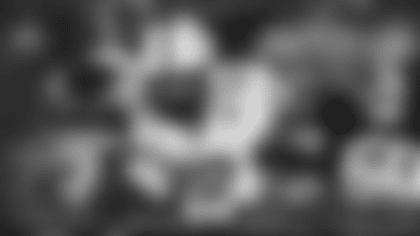1. Why the Colts didn't trade up to No. 3 – and how that benefitted the rest of their draft.
Once the Colts came to a collective decision that Anthony Richardson was the quarterback they wanted, they still had to draft him. That led to some tense moments in the Colts' draft room after the Carolina Panthers, as expected, picked Bryce Young No. 1 overall.
There was some uncertainty as to what would happen next. After months of back-and-forth speculation, the Houston Texans indeed selected a quarterback – Ohio State's C.J. Stroud – with the second overall pick. The Arizona Cardinals were on the clock, and it was clear they were trying to trade the No. 3 overall pick.
Maybe to a team that needed a quarterback. Maybe not. Maybe they wouldn't be successful trading the pick at all. But these were all maybes a little before 8:30 p.m. on Thursday.
Colts general manager Chris Ballard said he did call Arizona about trading up one spot, from No. 4 to No. 3. But Ballard, notably, has proven to adept at having a good feel for when he needs to be aggressive, when he can stand pat and when he can trade back and still get a player the team likes.
"I don't know how he does it, personally," Colts director of player personnel Kevin Rogers said last year on an episode of the Official Colts Podcast. "… Chris is phenomenal at exercising his resources, talking to as many people as he can and he does more reconnaissance work on who's into what, what players, what coaches are on and with what programs. He's phenomenal at it."
In this case?
"We just said, you know what, we're just going to sit and wait," Ballard said.
Instead of burning pick(s) this year or next year, Ballard was confident Richardson would be available at No. 4. But as the seconds melted away on Arizona's 10 minutes on the clock, there was some understandable uneasiness in the Colts' draft room.
"There is some tension with every pick, but with that one, obviously knowing, is someone going to trade up? We didn't know," Colts chief personnel executive Morocco Brown said. "Now, we did our due diligence and nothing was just by happenstance. But you don't know."
And then, the news hit: Arizona had traded the pick.
To the Texans.
Who weren't going to draft a quarterback after taking Stroud one pick earlier.
"When the trade happened," Colts Owner and CEO Jim Irsay said, "we all smiled in relief."
The Colts called Richardson as soon as they were on the clock. There was no last-second debate – this was The Guy, and it didn't take shipping away future draft picks to get him.
Now that we have a complete picture of the players the Colts selected in this year's NFL Draft, consider what they didn't give up to get Richardson. The last time a team traded up one spot in the top five to draft a quarterback, the Chicago Bears traded their third- and fourth-round picks, as well as a future third-round pick, to the San Francisco 49ers to swap the No. 2 and No. 3 overall picks in the 2017 NFL Draft.
If the Colts sent a similar package to the Cardinals, they would've came away from this year's draft without wide receiver Josh Downs (No. 79 overall) and offensive tackle Blake Freeland (No. 106 overall). Instead, Downs and Freeland could develop into guys who can catch and block, respectively, for Richardson for years to come.
"I'll give it to Chris," Brown said. "Everybody couldn't do that and sit there and say, 'Look, let's let it play out. We feel good about where we are.' It just shows his belief in the information he was able to find out and his belief in, 'Hey, I think we'll be able to get the guy here.'
"Then once we saw the trade and we saw that it was Houston, it was this gigantic sigh of relief."
2. By trading back three times, the Colts came away with their largest draft class in recent memory.
Not only did the Colts keep some Day 2 and Day 3 picks by hanging at No. 4, they traded back twice on Day 2 and once on Day 3 to accumulate a total of 12 draft picks.
The Colts began Friday with the No. 35 overall pick – the fourth selection in the second round – and a clump of five or six players they liked. The depth of this year's draft allowed Ballard to feel confident he could trade back and still get a guy the Colts valued.
So first, the Colts traded back from pick No. 35 to 38 with the Las Vegas Raiders, adding a fifth-round selection (No. 141 overall) in the process. Then, the Colts traded pick No. 38 to the Atlanta Falcons for the Nos. 44 and 110 selections. At No. 44, the Colts picked Kansas State cornerback Julius Brents.
"We like the talent at that level as we kept moving down," Ballard said. "And then the ability to add the extra picks, especially the extra fourth where we think there are some pretty good players we thought that value was too good to pass up."
And on Day 3, the Colts traded the pick they acquired from the Raiders – No. 141 – to the Minnesota Vikings for a fifth-round pick (No. 158 overall) and a sixth-round pick (No. 211 overall).
In total, those three trades netted the Colts:
- DT Adetomiwa Adebawore (No. 110)
- S Daniel Scott (No. 158)
- DE Titus Leo (No. 211)
The Colts, under Ballard, have consistently unearthed starting-caliber, key depth and/or core special teams players on Day 3 of the NFL Draft (most recently: safety Rodney Thomas II, the No. 239 overall pick in the 2022 NFL Draft who led the team in interceptions last season). And by betting on players who possess a combination of high-end athletic traits and football character, the Colts believe in the value of taking as many shots as possible on those players – especially on Day 3 of the draft.
The 12 draft picks made by the Colts in 2023 are the most for the franchise since the NFL Draft went from 12 rounds to eight in 1993, then down to seven in 1994. The previous high water mark was 11 selections in 2018.
3. Cornerback will be one of the most competitive positions on the roster in the next few months.
The Colts added Brents (No. 44 overall), Darius Rush (No. 138 overall) and Jaylon Jones (No. 221 overall) over the course of the draft, and those guys will join Kenny Moore II, Isaiah Rodgers Sr., Tony Brown and Dallis Flowers, among others in Indianapolis.
And all three cornerbacks the Colts drafted are the kind of long athletes that "fit our profile," Ballard said.
"We wanted to add competition to that position, which I think we were able to do," Ballard said. "The room is going to look a little different with these guys added."
A quick look at a few key measurements (via Mockdraftable.com) and notes on each player:
Julius Brents
- Height: 6-foot-3 (96th percentile for cornerbacks)
- Arm length: 34 inches (98th percentile)
- Wingspan: 82 5/8 inches (99th percentile)
- Vertical jump: 41.5 inches (96th percentile)
- Broad jump: 138 inches (99th percentile)
"It's hard to find guys that are 6-3, 200 pounds, have 34-inch arms and move around as well as he does," Colts area scout Tyler Hughes said. "Not only can he run in a straight line, but the athleticism, the quickness, the feet — he's improved every year since he was at Iowa all the way up to K-State now."
The Colts like Brents' upside as a long, athletic corner who can play press coverage in Gus Bradley's defense, and value the Indianapolis native's physical and mental toughness. And while Brents may not be the fastest cornerback – he ran a 4.5-second 40-yard dash – he's able to use his remarkable length to his advantage.
"Even the 4.50 – When you're 6-3, there's a difference," Ballard said. "It gives you an advantage down the field because you're not throwing over a 5-9, 5-10 guy. You're throwing over a 6-3 guy. That looks different to a quarterback."
Darius Rush
- Height: 6-foot-2 (93rd percentile)
- Arm length: 33 3/8 inches (95th percentile)
- 40-yard dash: 4.36 seconds (92nd percentile)
Rush is a "late bloomer," assistant director of college scouting Jamie Moore said, as he converted from wide receiver to cornerback during his college career at South Carolina. But he began using his blend of length and speed to his advantage over his last few years in college; Rush totaled 18 passes defensed across the 2021 and 2022 seasons. The Colts see him as someone with good ball skills – again, he's a converted wide receiver – and plenty of upside.
"You go back and watch his career, he's just continued to ascend," Moore said. "He's gotten better each year. And I definitely think the best is yet to come from this young man."
Jaylon Jones
- Height: 6-foot-2 (93rd percentile)
- Weight: 200 pounds (78th percentile)
- 40-yard dash 10-yard split: 1.48 seconds (92nd percentile)
Like Brents and Rush, Jones' height stands out, and he displayed impressive physicality in college at Texas A&M. He totaled three interceptions and 14 pass break-ups in 32 games, and in 2022 he allowed only one reception of 20 or more yards.
4. Josh Downs broke a mold, but fits the Colts' receiver room well.
At 5-foot-9, Downs is the shortest wide receiver drafted by the Colts since T.Y. Hilton (also 5-foot-9) in 2012; at 171 pounds, he's the lightest wide receiver drafted by the Colts since at least 2000.
The five wide receivers Ballard previously drafted were, on average, about 6-foot-3 and 213 pounds.
But Downs' speed, quickness and explosiveness – not to mention his college production at North Carolina – all attracted the Colts to him throughout the draft process. And, too, he complements the 6-foot-4 Michael Pittman Jr. and 6-foot-3 Alec Pierce well.
"We don't have a whole lot of guys like him," area scout Chad Henry said. "He's a human chain mover. Good luck covering him in a short area."
Downs primarily played in the slot (1,419 snaps) in college but did get some time as an outside receiver in 2022 (133 snaps), per Pro Football Focus. He has good hands – three drops against 94 receptions in 2022 – and his short-area quickness and feel for space made him a favorite target of Tarheels quarterback and potential top 2024 NFL draft prospect Drake Maye. Downs totaled 195 catches for 2,364 yards with 19 touchdowns over his final two seasons in Chapel Hill.
"Downs is a crafty route runner in the slot," head coach Shane Steichen said. "He had a lot of production at North Carolina. He just has a really good natural feel. I mean this guy is a football player and can find the dead spots in zone coverage. He just has a knack for getting open so really excited to about him."
And Downs wowed Reggie Wayne – the should-be Hall of Fame wide receiver and current Colts wide receivers coach – with his work at the NFL Combine earlier this year. And when Wayne sticks his neck out for a wide receiver, "it only makes it that much better," Henry said.
On top of Downs' athleticism and receiving ability, his personality, work ethic and football character are a "slam dunk," Henry said. Downs grew up around the game – his dad, Gary, spent seven seasons as an NFL running back (1994-2000), and his uncle, Dre Bly, was a two-time Pro Bowl cornerback who played a decade in the NFL (1999-2009).
"He's a great kid," Henry said. "You see that he was raised not only around football, but he was raised right. I mean, his parents are really good people. You can see that reflected with the kid that he is. His football character is awesome. There's not a person in the building at North Carolina that has one bad thing to say about him, and they all gush about him."
View photos from Kansas City of QB Anthony Richardson selected 4th overall by the Colts in the 2023 NFL Draft.

People are reflected in the glasses of Florida quarterback Anthony Richardson on the red carpet before the first round of the NFL football draft, Thursday, April 27, 2023, in Kansas City, Mo. (AP Photo/Charlie Riedel)

Florida quarterback Anthony Richardson poses for a photo during the 2023 NFL Draft on Thursday, April 27, 2023 in Kansas City, Missouri. (Todd Rosenberg/NFL)

Florida quarterback Anthony Richardson arrives prior to the 2023 NFL Draft on Thursday, April 27, 2023 in Kansas City, Missouri. (Todd Rosenberg/NFL)

Florida quarterback Anthony Richardson poses for a photo during the 2023 NFL Draft on Thursday, April 27, 2023 in Kansas City, Missouri. (Todd Rosenberg/NFL)

Florida quarterback Anthony Richardson poses for a photo during the 2023 NFL Draft on Thursday, April 27, 2023 in Kansas City, Missouri. (Todd Rosenberg/NFL)

Florida quarterback Anthony Richardson poses for a photo during the 2023 NFL Draft on Thursday, April 27, 2023 in Kansas City, Missouri. (Todd Rosenberg/NFL)

Florida quarterback Anthony Richardson poses for a photo during the 2023 NFL Draft on Thursday, April 27, 2023 in Kansas City, Missouri. (Todd Rosenberg/NFL)

Florida quarterback Anthony Richardson poses for a photo during the 2023 NFL Draft on Thursday, April 27, 2023 in Kansas City, Missouri. (Todd Rosenberg/NFL)

Florida quarterback Anthony Richardson poses for a photo during the 2023 NFL Draft on Thursday, April 27, 2023 in Kansas City, Missouri. (Todd Rosenberg/NFL)

Florida quarterback Anthony Richardson poses for a photo during the 2023 NFL Draft on Thursday, April 27, 2023 in Kansas City, Missouri. (Todd Rosenberg/NFL)

Florida quarterback Anthony Richardson poses for a photo during the 2023 NFL Draft on Thursday, April 27, 2023 in Kansas City, Missouri. (Todd Rosenberg/NFL)

Florida quarterback Anthony Richardson arrives prior to the 2023 NFL Draft on Thursday, April 27, 2023 in Kansas City, Missouri. (Todd Rosenberg/NFL)

Florida quarterback Anthony Richardson poses for a photo during the 2023 NFL Draft on Thursday, April 27, 2023 in Kansas City, Missouri. (Todd Rosenberg/NFL)

Florida quarterback Anthony Richardson arrives prior to the 2023 NFL Draft on Thursday, April 27, 2023 in Kansas City, Missouri. (Todd Rosenberg/NFL)

Florida quarterback Anthony Richardson arrives prior to the 2023 NFL Draft on Thursday, April 27, 2023 in Kansas City, Missouri. (Todd Rosenberg/NFL)

Florida quarterback Anthony Richardson arrives prior to the 2023 NFL Draft on Thursday, April 27, 2023 in Kansas City, Missouri. (Todd Rosenberg/NFL)

Florida quarterback Anthony Richardson arrives prior to the 2023 NFL Draft on Thursday, April 27, 2023 in Kansas City, Missouri. (Todd Rosenberg/NFL)

Florida quarterback Anthony Richardson arrives prior to the 2023 NFL Draft on Thursday, April 27, 2023 in Kansas City, Missouri. (Todd Rosenberg/NFL)
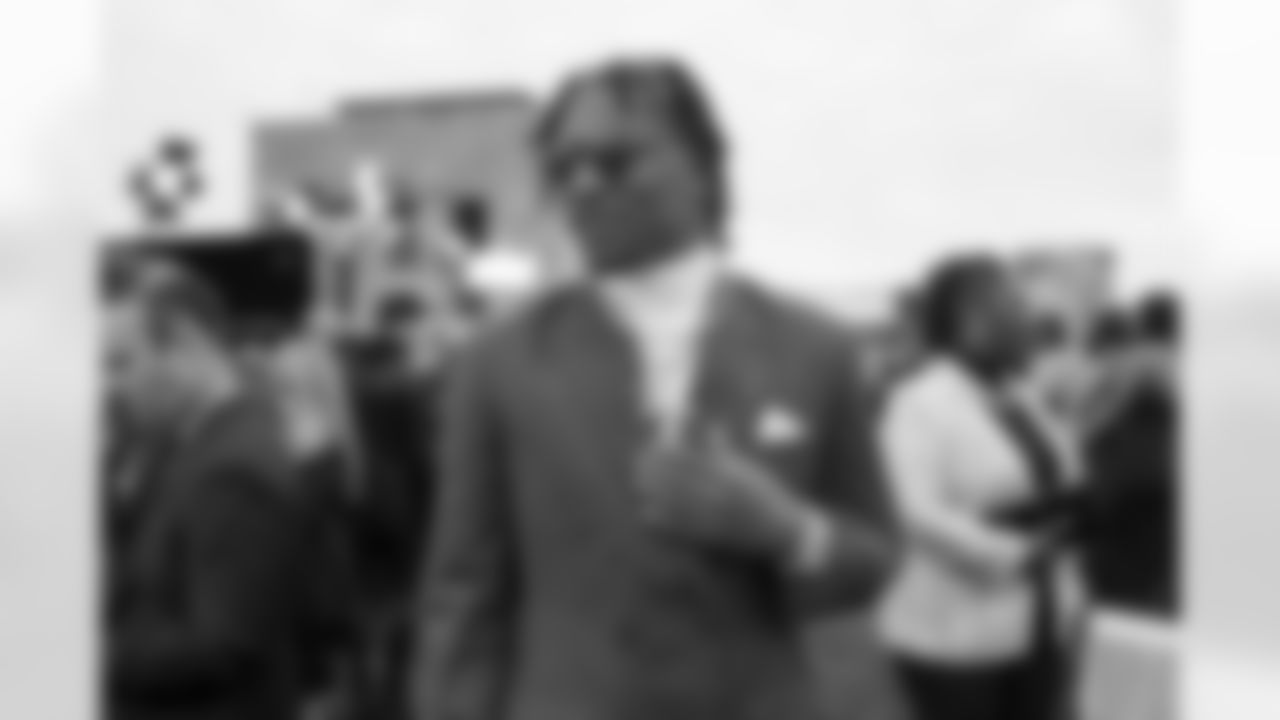
Florida quarterback Anthony Richardson arrives prior to the 2023 NFL Draft on Thursday, April 27, 2023 in Kansas City, Missouri. (Todd Rosenberg/NFL)

Florida quarterback Anthony Richardson arrives prior to the 2023 NFL Draft on Thursday, April 27, 2023 in Kansas City, Missouri. (Todd Rosenberg/NFL)

Florida quarterback Anthony Richardson reacts after being selected during the 2023 NFL Draft on Thursday, April 27, 2023 in Kansas City, Missouri. (Kevin Sabitus/NFL)

Florida quarterback Anthony Richardson reacts after being selected during the 2023 NFL Draft on Thursday, April 27, 2023 in Kansas City, Missouri. (Kevin Sabitus/NFL)

Florida quarterback Anthony Richardson arrives prior to the 2023 NFL Draft on Thursday, April 27, 2023 in Kansas City, Missouri. (Todd Rosenberg/NFL)

Florida quarterback Anthony Richardson reacts after being selected during the 2023 NFL Draft on Thursday, April 27, 2023 in Kansas City, Missouri. (Kevin Sabitus/NFL)

Florida quarterback Anthony Richardson in the green room during the 2023 NFL Draft on Thursday, April 27, 2023 in Kansas City, Missouri. (Kevin Sabitus/NFL)

Florida quarterback Anthony Richardson reacts after being selected during the 2023 NFL Draft on Thursday, April 27, 2023 in Kansas City, Missouri. (Kevin Sabitus/NFL)

Florida quarterback Anthony Richardson in the green room during the 2023 NFL Draft on Thursday, April 27, 2023 in Kansas City, Missouri. (Kevin Sabitus/NFL)

Florida quarterback Anthony Richardson during the 2023 NFL Draft on Thursday, April 27, 2023 in Kansas City, Missouri. (Kevin Sabitus/NFL)

Florida quarterback Anthony Richardson reacts after being selected during the 2023 NFL Draft on Thursday, April 27, 2023 in Kansas City, Missouri. (Kevin Sabitus/NFL)

Florida quarterback Anthony Richardson reacts after being selected during the 2023 NFL Draft on Thursday, April 27, 2023 in Kansas City, Missouri. (Kevin Sabitus/NFL)

Penn State cornerback Joey Porter Jr., Florida quarterback Anthony Richardson and Ohio State wide receiver Jaxon Smith-Njigba during the 2023 NFL Draft on Thursday, April 27, 2023 in Kansas City, Missouri. (Kevin Sabitus/NFL)

Florida quarterback Anthony Richardson reacts after being selected during the 2023 NFL Draft on Thursday, April 27, 2023 in Kansas City, Missouri. (Kevin Sabitus/NFL)

Florida quarterback Anthony Richardson, Texas running back Bijan Robinson, Ohio State wide receiver Jaxon Smith-Njigba and Ohio State quarterback CJ Stroud during the 2023 NFL Draft on Thursday, April 27, 2023 in Kansas City, Missouri. (Kevin Sabitus/NFL)

Florida quarterback Anthony Richardson with Alabama quarterback Bryce Young in the green room during the 2023 NFL Draft on Thursday, April 27, 2023 in Kansas City, Missouri. (Kevin Sabitus/NFL)

Kentucky quarterback Will Levis, Penn State cornerback Joey Porter Jr., Florida quarterback Anthony Richardson and Ohio State wide receiver Jaxon Smith-Njigba during the 2023 NFL Draft on Thursday, April 27, 2023 in Kansas City, Missouri. (Kevin Sabitus/NFL)

Florida quarterback Anthony Richardson, Texas running back Bijan Robinson, Ohio State wide receiver Jaxon Smith-Njigba and Ohio State quarterback CJ Stroud during the 2023 NFL Draft on Thursday, April 27, 2023 in Kansas City, Missouri. (Kevin Sabitus/NFL)

Florida quarterback Anthony Richardson is interviewed during the 2023 NFL Draft on Thursday, April 27, 2023 in Kansas City, Missouri. (Ben Liebenberg/NFL)

A detailed view of Florida quarterback Anthony Richardson's chain worn during the 2023 NFL Draft on Thursday, April 27, 2023 in Kansas City, Missouri. (Ben Liebenberg/NFL)

Florida quarterback Anthony Richardson poses on stage during the 2023 NFL Draft on Thursday, April 27, 2023 in Kansas City, Missouri. (Ben Liebenberg/NFL)

Florida quarterback Anthony Richardson embraces family during the 2023 NFL Draft on Thursday, April 27, 2023 in Kansas City, Missouri. (Aaron Doster/NFL)

Florida quarterback Anthony Richardson gesturesduring the 2023 NFL Draft on Thursday, April 27, 2023 in Kansas City, Missouri. (Ben Liebenberg/NFL)

Florida quarterback Anthony Richardson gets emotional as he walks to the stage after being selected during the 2023 NFL Draft on Thursday, April 27, 2023 in Kansas City, Missouri. (Ben Liebenberg/NFL)

Florida quarterback Anthony Richardson and NFL commissioner Roger Goodell embrace during the 2023 NFL Draft on Thursday, April 27, 2023 in Kansas City, Missouri. (Aaron Doster/NFL)

Florida quarterback Anthony Richardson gets emotional as he walks to the stage after being selected during the 2023 NFL Draft on Thursday, April 27, 2023 in Kansas City, Missouri. (Ben Liebenberg/NFL)
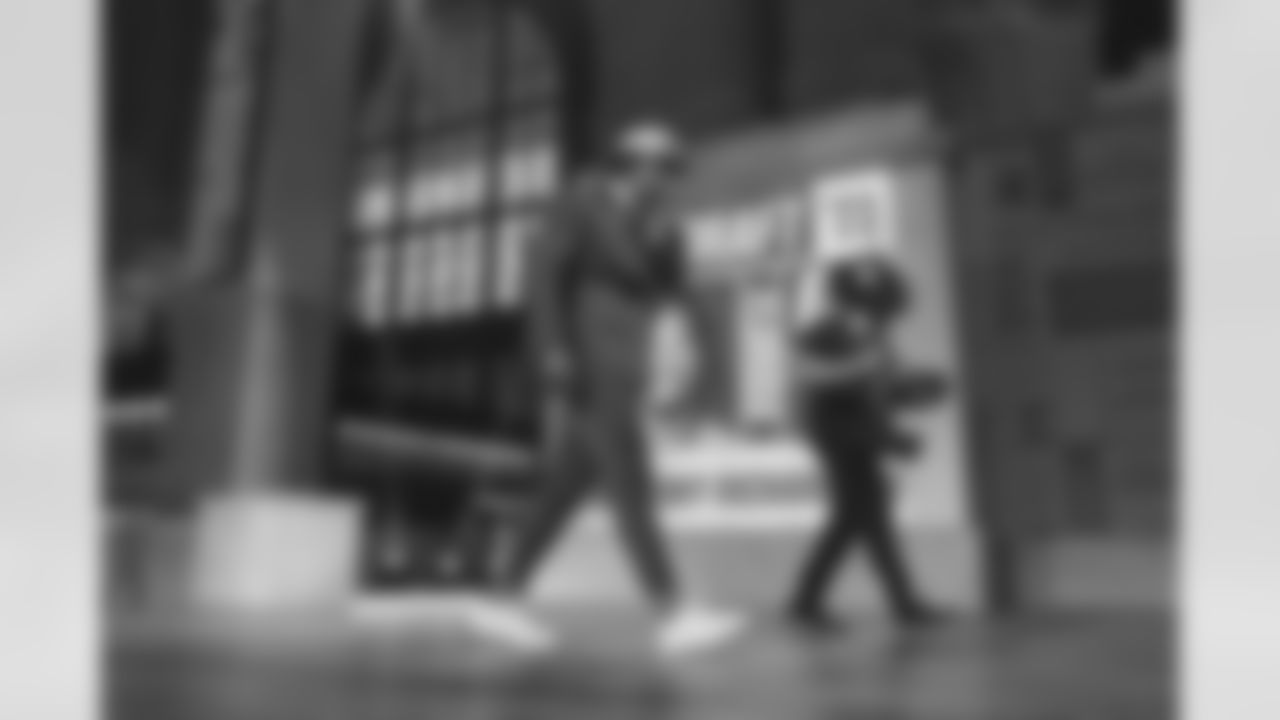
Florida quarterback Anthony Richardson walks onstage during the 2023 NFL Draft on Thursday, April 27, 2023 in Kansas City, Missouri. (Aaron Doster/NFL)

Florida quarterback Anthony Richardson gets emotional as he walks to the stage after being selected during the 2023 NFL Draft on Thursday, April 27, 2023 in Kansas City, Missouri. (Ben Liebenberg/NFL)
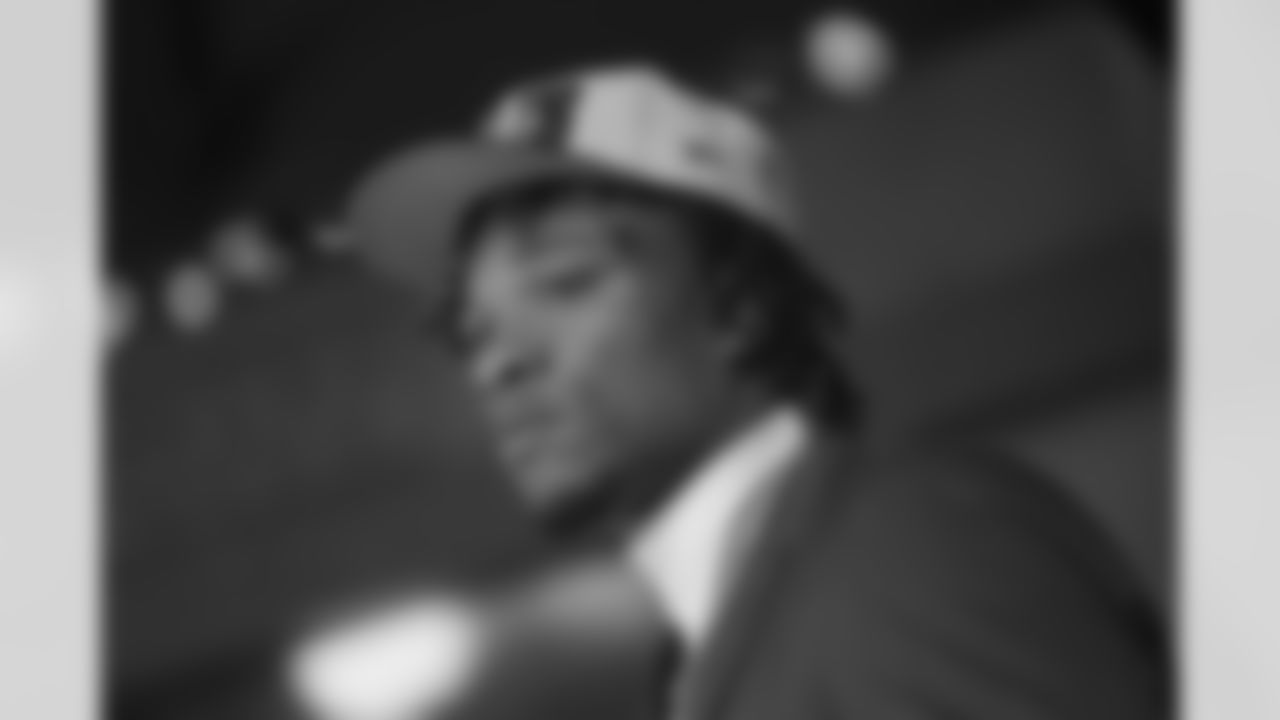
Florida quarterback Anthony Richardson looks on during the 2023 NFL Draft on Thursday, April 27, 2023 in Kansas City, Missouri. (Aaron Doster/NFL)

Florida quarterback Anthony Richardson and NFL commissioner Roger Goodell pose for a photo during the 2023 NFL Draft on Thursday, April 27, 2023 in Kansas City, Missouri. (Aaron Doster/NFL)

Florida quarterback Anthony Richardson, left, and Roger Goodell, NFL Commissioner, hold a team jersey after Richardson was chosen by the Indianapolis Colts with the No. 4 pick at the 2023 NFL Draft, Thursday, April 27, 2023, in Kansas City, Mo. (AP Photo/Steve Luciano)

Florida quarterback Anthony Richardson poses for a photo during the 2023 NFL Draft on Thursday, April 27, 2023 in Kansas City, Missouri. (Aaron Doster/NFL)

Florida quarterback Anthony Richardson takes the stage during the 2023 NFL Draft on Thursday, April 27, 2023 in Kansas City, Missouri. (Aaron Doster/NFL)

Florida quarterback Anthony Richardson walks onstage during the 2023 NFL Draft on Thursday, April 27, 2023 in Kansas City, Missouri. (Aaron Doster/NFL)

Florida quarterback Anthony Richardson puts on a hat after being chosen by the Indianapolis Colts with the fourth overall pick during the first round of the NFL football draft, Thursday, April 27, 2023, in Kansas City, Mo. (AP Photo/John Locher)

Florida Quarterback Anthony Richardson poses for a photo after being elected by the Indianapolis Colts in the first round of the NFL draft, Thursday, April 27, 2023, in Kansas City, Mo. (AP Images for NFL/Doug Benc)
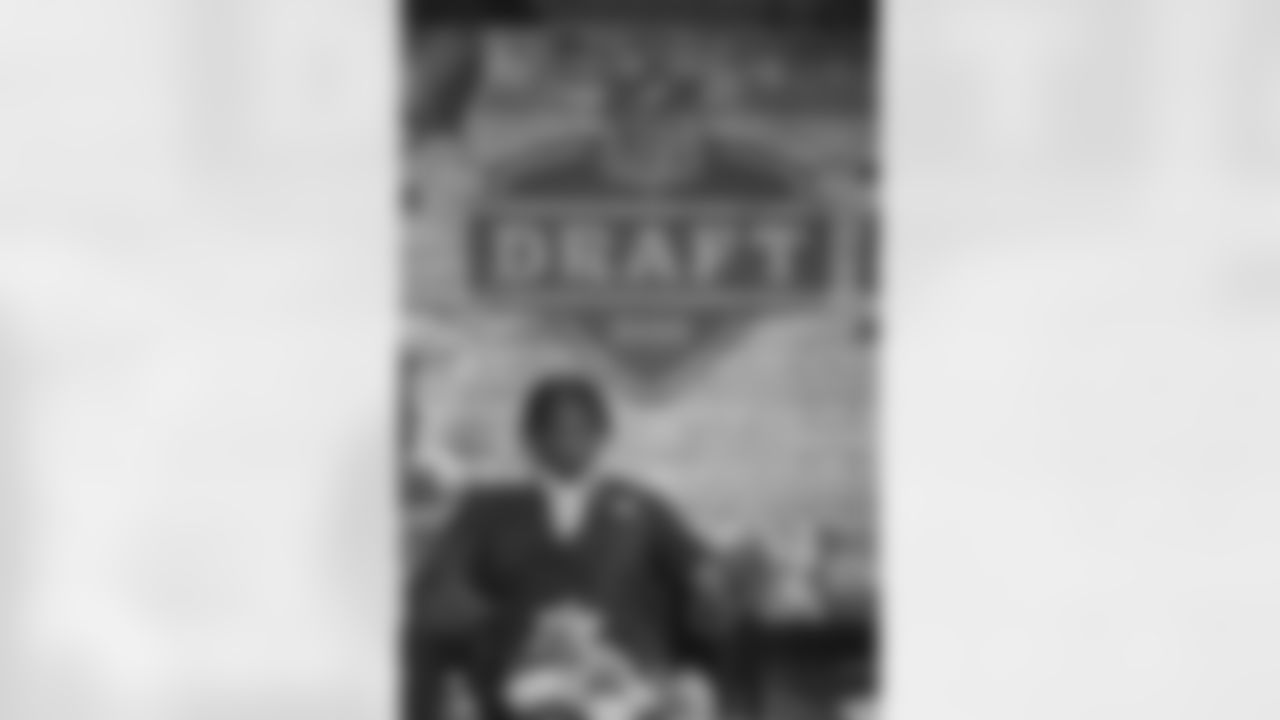
Florida Quarterback Anthony Richardson waits in the green room to be drafted at the 2023 NFL Draft on Thursday, April 27, in Kansas City, Mo. (AP Images for NFL/Doug Benc)

Florida quarterback Anthony Richardson, left, and Roger Goodell, NFL Commissioner, hold a team jersey after Richardson was chosen by the Indianapolis Colts with the No. 4 pick at the 2023 NFL Draft, Thursday, April 27, 2023, in Kansas City, Mo. (AP Photo/Steve Luciano)

Florida quarterback Anthony Richardson reacts after being chosen by the Indianapolis Colts with the fourth overall pick during the first round of the NFL football draft, Thursday, April 27, 2023, in Kansas City, Mo. (AP Photo/Jeff Roberson)

Florida quarterback Anthony Richardson reacts after being chosen by the Indianapolis Colts with the fourth overall pick during the first round of the NFL football draft, Thursday, April 27, 2023, in Kansas City, Mo. (AP Photo/Jeff Roberson)

Florida quarterback Anthony Richardson reacts after being chosen by the Indianapolis Colts with the fourth overall pick during the first round of the NFL football draft, Thursday, April 27, 2023, in Kansas City, Mo. (AP Photo/Jeff Roberson)

Florida quarterback Anthony Richardson arrives on the red carpet before the first round of the NFL football draft, Thursday, April 27, 2023, in Kansas City, Mo. (AP Photo/Charlie Riedel)

Florida quarterback Anthony Richardson, left, embraces NFL Commissioner Roger Goodell after being chosen by the Indianapolis Colts with the fourth overall pick during the first round of the NFL football draft, Thursday, April 27, 2023, in Kansas City, Mo. (AP Photo/Jeff Roberson)
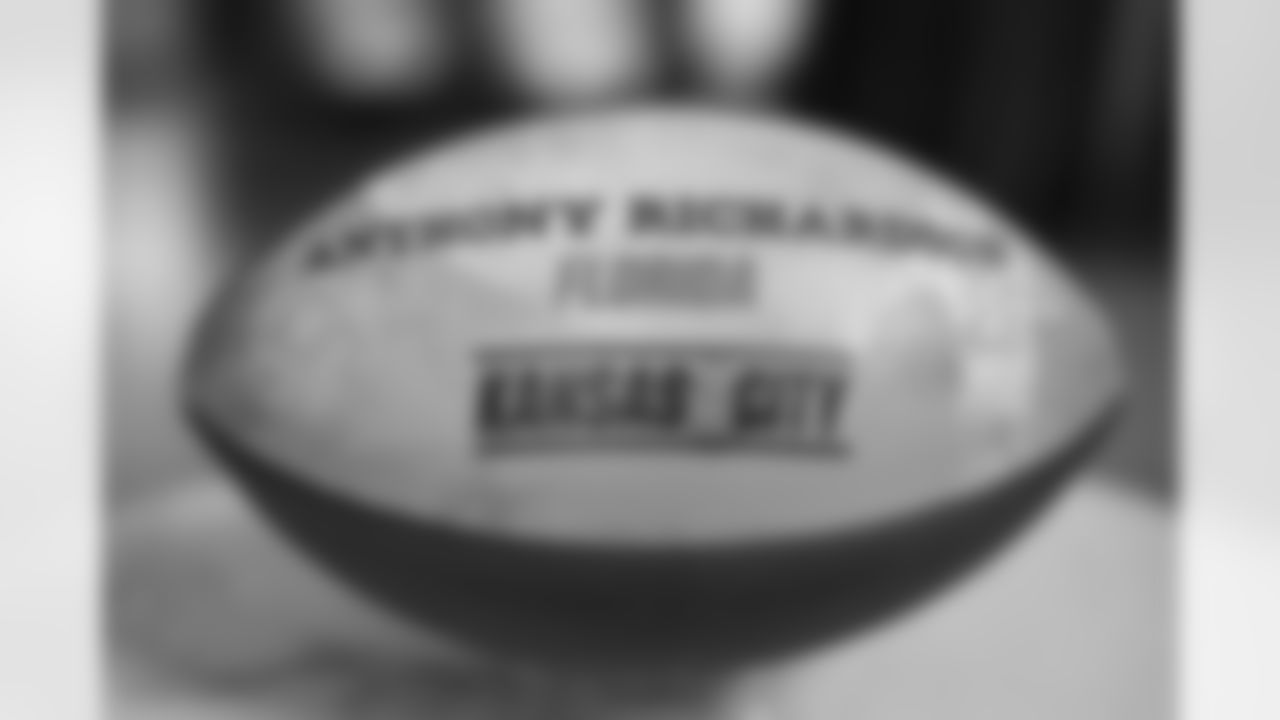
A detail shot of an Anthony Richardson football in the green room backstage prior to the 2023 NFL Draft, Thursday, April 27, 2023 in Kansas City, Mo. (Kevin Sabitus via AP)

Florida quarterback Anthony Richardson arrives on the red carpet before the first round of the NFL football draft, Thursday, April 27, 2023, in Kansas City, Mo. (AP Photo/Charlie Riedel)

Florida quarterback Anthony Richardson reacts after being chosen by the Indianapolis Colts with the fourth overall pick during the first round of the NFL football draft, Thursday, April 27, 2023, in Kansas City, Mo. (AP Photo/Jeff Roberson)
5. The right time for five.
Back to Richardson for a moment here. The new Colts quarterback said he's planning on wearing No. 5, which was his first number when he started playing football as a "little, little, little" kid in Miami.
Richardson wore No. 15 at Florida last season but began his college career wearing No. 2 as an homage to the quarterback he molded his game after: Cam Newton.
But in No. 5, Richardson wants to forge his own path and legacy while going back to his playing roots.
"I feel like that's what set the foundation for me," Richardson said. "I used to rock No. 2 because of Cam. I love No. 2, that was my number, but I don't want to be known as the guy that wants to be like Cam anymore. I just want to be myself and I want to set the standard and the priorities for myself."
6. Blake Freeland and Jake Witt were big, athletic swings at tackle on Day 3.
The Colts bookended the final day of the draft with two upside-packed tackles in Freeland (fourth round, No. 106 overall) and Witt (seventh round, No. 236 overall).
The 6-foot-8 Freeland recorded a 37-inch vertical (99th percentile for tackles) and 120-inch broad jump (98th percentile) at the NFL Combine. And he's more than just a raw athlete – Freeland allowed only two sacks and 41 total pressures in 1,346 pass blocking snaps at BYU from 2019-2022.
The Colts view Freeland as a swing tackle – he has experience playing both right and left tackle – with the potential to develop into more than that as he adjusts to the NFL.
"He can play two spots, and he's done it in college, too — he played right tackle for two years and he played left tackle the last two years," area scout Chris McGaha said. "The exciting thing is, he comes in, competes, sees what happens and you feel good about the fact that the guy can play multiple spots and have versatility for you and maybe get you out of a pinch or whatever that might look like."
Then there's Witt, a native of Michigan's Upper Peninsula – which hasn't produced an NFL player in nearly 30 years (the last, according to Uppermichigansource.com, was former Miami Dolphins defensive tackle Chuck Klingbeil, who played from 1991-1995). But you never know where you may unearth a talented, athletic player – and Witt certainly fits that bill.
He got on the Colts' radar earlier this year and roundly impressed NFL teams with his pro day workout, where he ran a 4.89-second 40-yard dash and recorded a 37-inch vertical. Witt was a guy who the Colts wanted to get in their building, and felt like there would be plenty of teams interested in signing him as an undrafted free agent. So, to ensure they gave themselves a chance to develop Witt, they nabbed him with their final selection of the 2023 NFL Draft.
"He's raw and it's going to take him some time," Ballard said. "... He's got all the athletic traits you look for. He hasn't played a lot of football. So, we'll see if we can develop him. I think we can. We sent Tony (Sparano Jr.) to work him out. Tony came back raving saying, 'Look, I think we can make this guy a player.' Then I knew the competition was going to be so heavy after the draft, I said, 'Screw it. We're just going to draft him.'"
7. The Colts' defensive line depth is taking shape.
Ballard prioritizes having a defensive line room that's eight or nine players deep, and adding defensive tackle Adetomiwa Adebawore in the fourth round and defensive end Titus Leo in the sixth round pushes the Colts toward that number.
There should be good competition and depth on the interior of the Colts' defensive line, which is headlined by DeForest Buckner and Grover Stewart and also features Adebawore, Taven Bryan, Eric Johnson II, Chris Williams and McTelvin Agim.
The Colts valued Adebawore's versatility and athleticism and project him as a three-technique defensive tackle with some "unique traits for the position," Ballard said.
At defensive end, the Colts have Leo, Kwity Paye, Dayo Odeyingbo, Samson Ebukam, Tyquan Lewis, Rashod Berry, Khalid Kareem and Kameron Cline.
Leo impressed the Colts at the East-West Shrine Bowl earlier this year and solidified his place on their draft board on a top-30 visit to the Indiana Farm Bureau Football Center this spring. Henry said Leo plays "100 miles per hour" and fits the Colts' D-line emphasis on attacking and penetrating.
"You talk about a guy who plays with his hair on fire," Henry said, "he can run, got some pass rush ability, he's a good kid, he wants to win, he wants to play football the right way."
And with those additions in free agency and the draft, defensive line coach Nate Ollie will have plenty of players to coach and have compete in the coming weeks and months.
"With the additions of Samson, Taven and now adding Tomi plus what we already had on the roster, now we're starting to get a group that's got eight, nine players that we can rotate in and out," Ballard said. "We added a lot of competition, that's for sure."
8. Daniel Scott's baseline could be a core special teamer with upside on defense.
Scott arrived at the University of California in 2017, but didn't become a full-time starter until 2021. While others might've transferred to try to find immediate playing time, Scott stuck things out and carved out a role on special teams. He played 656 snaps on special teams in college.
And when Scott earned a starting role in 2021, he still contributed on special teams – a commitment that isn't a given for college players.
"Some guys will play it early in their career and maybe not play it when they're juniors or seniors, but he's played special teams, he's had production," McGaha said. "He's also played a lot of different roles for them in their defense. He's play single high and playing the post, they spin him down, play him in the box."
Scott – like the rest of the Colts' draft picks – is a high-end athlete. He ran a 4.45-second 40-yard dash (84th percentile for safeties), had a 39.5-inch vertical (89th percentile) and is strong, too – he had 22 bench press reps at the NFL Combine (88th percentile).
"This guy is an instinctive, athletic, fast player," Ballard said. "We think it's going to help him. Adds depth to the position. A guy we've kind of been following the whole time through the process and liking every step along the way. He adds great depth and I think he'll compete. I think he'll be in the mix to compete, to play."
The Colts' safety room will have some good competition in 2023, too, with Scott joining Rodney Thomas II, Julian Blackmon, Nick Cross, Trevor Denbow, Henry Black and Marcel Dabo on the roster right now.
9. Will Mallory was too talented to pass up in the fifth round.
Moore, who scouted Mallory, has known about him for years – dating all the way back to Mallory's prep days at Providence School of Jacksonville, where his high school quarterback was Gus Bradley's son, Carter. As Moore followed Mallory's career at Miami, he saw a "super consistent performer" with plenty of athletic upside.
Mallory averaged 13.4 yards per reception across five collegiate seasons at Miami and brings rare speed for the position – his 4.54-second 40-yard dash was the fastest among the 104 draft-eligible tight ends tracked in Dane Brugler's "The Beast" draft guide.
"The speed that he brings – he catches some shallow routes, underneath routes, seam balls," Steichen said. "You can just see the explosiveness when he catches that ball and then takes off and runs. It will be good."
The Colts didn't have a glaring need at tight end, with Mo Alie-Cox, Pharaoh Brown, Kylen Granson, Nikola Kalinic, Drew Ogletree, Jelani Woods and Jalen Wydermyer on the roster already. But, as Moore said, the goal of the NFL Draft is to "get as many good football players as we can on our team."
And, like at cornerback, defensive line and several other positions, there will be intense competition in Tom Manning's tight end room in 2023.
"He's a really good fit for what we want," Ballard said. "It's just going to create real competition at the position. That's OK. That's a good thing. That makes you better."
10. Evan Hull fills a sneaky need.
In 2021, about 22 percent of Jalen Hurts' completions were to his running backs.
In 2020, about 32 percent of Justin Herbert's completions were to his running backs.
The through line there between those two young quarterbacks: Their offensive coordinator. Shane Steichen.
"Your best friend is gonna be the tailback," Steichen told Herbert.
"It's all about getting completions, completions, completions," Steichen said in an interview on the Colts Audio Network shortly after being hired in February. "Hey, we go max play-action and it ain't there, just check it down and shoot, tailback makes one miss, you might get 15-20 yards and that's a chunk play. So just keep the sticks moving as much as we can and that's how we go."
With that context, it's easy to see why the Colts targeted Hull – who led all Division I running backs with 55 receptions in 2022, and only had five drops on 116 targets over four seasons at Northwestern.
"He can really catch the football," Ballard said.
While Jonathan Taylor is, of course, in line to get the lion's share of snaps at running back, the Colts see Hull as a versatile option who can contribute as a blocker and operate as a safety valve for Richardson, if and when he plays.
"He's good in pass pro, he can play on (special) teams, he can do a lot of different things," Ballard said. "So we're excited where we were able to get him in the draft."















